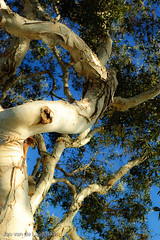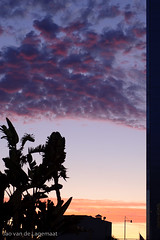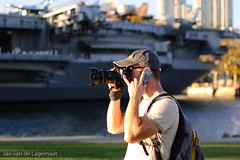 Last week I was for my science work at the SPIE conference that was being held in San Diego. This is an excellent conference on optical phenomena, photovoltaics, microscopy and more.
Last week I was for my science work at the SPIE conference that was being held in San Diego. This is an excellent conference on optical phenomena, photovoltaics, microscopy and more.  It also has a track on more classical lens design. In a strange collosion between my two worlds, I met Ken Rockwell there. Ken maintains a funny and often instructive website that is well known and often controversial among net-connected photographers or people who just like to wax endlessly about gear online. I often disagree with his more strong opinions (although I often suspect he is pulling our legs), but often strongly agree with them. It is always entertaining however not in the least because his photography often featuring retina-burning saturation. But I digress.
It also has a track on more classical lens design. In a strange collosion between my two worlds, I met Ken Rockwell there. Ken maintains a funny and often instructive website that is well known and often controversial among net-connected photographers or people who just like to wax endlessly about gear online. I often disagree with his more strong opinions (although I often suspect he is pulling our legs), but often strongly agree with them. It is always entertaining however not in the least because his photography often featuring retina-burning saturation. But I digress.This encounter made me think about other areas where my two worlds meet. Of course I interject a lot of my science geekiness into my photography as I know and understand sensors, how film works, dyes, how light interacts with matter, how semiconductors work, how light scattering works, and much more.
 This is tremendously helpful in understanding my gear and light in general. There are also areas however, where the inverse happens and where photography enters my science life. One of those occurances happened when I recently opened a closet at my work and found stacks and stacks of boxes of unexposed 4x5 black and white polaroids. These were probably once used for electron microscopy, but they are the exact same stuff you would use in a viewcamera to get a quick check before exposing the real negative. Electron microscopy has gone completely digital now and nobody in that field uses this stuff anymore as the digital capture has many advantages even though the film captures were always spectacular. We used to have a darkroom down there too that has gone defunct for obvious reasons. The warning sign is still there.
This is tremendously helpful in understanding my gear and light in general. There are also areas however, where the inverse happens and where photography enters my science life. One of those occurances happened when I recently opened a closet at my work and found stacks and stacks of boxes of unexposed 4x5 black and white polaroids. These were probably once used for electron microscopy, but they are the exact same stuff you would use in a viewcamera to get a quick check before exposing the real negative. Electron microscopy has gone completely digital now and nobody in that field uses this stuff anymore as the digital capture has many advantages even though the film captures were always spectacular. We used to have a darkroom down there too that has gone defunct for obvious reasons. The warning sign is still there.As another example, I do a lot of work on plastic solar cells.
 These are solar cells that can be made basically as cheap as paint and on flexible substrates. I wrote a small SPIE newsroom article on my work for non-experts for SPIE a while ago that you can read in the link if you're interested. It happens that several companies have started producing such solar cells on roll-to-roll facilities that were bought and modified from coaters used in the now mostly defunct film industry. A great example of such a company is Konarka in Bedford Massachusetts that bought up an old Polaroid plant.
These are solar cells that can be made basically as cheap as paint and on flexible substrates. I wrote a small SPIE newsroom article on my work for non-experts for SPIE a while ago that you can read in the link if you're interested. It happens that several companies have started producing such solar cells on roll-to-roll facilities that were bought and modified from coaters used in the now mostly defunct film industry. A great example of such a company is Konarka in Bedford Massachusetts that bought up an old Polaroid plant.  They are now spewing out many meters of "power plastic" at fantastic rates. On the one hand, it is sad to see the film industry (safe for some significant holdouts) being assimilated, but on the other hand it is good to see that this technology is being used in a new and very useful manner. Another area that enters in my science work is small silver nanoparticles. Once the reason behind the black coloring in photographic film and paper, now I use these as "plasmonically" active centers in my solar cells and in other applications. Much of the science behind making these particles and their chemistry was worked out ages ago mostly for photographic applications!
They are now spewing out many meters of "power plastic" at fantastic rates. On the one hand, it is sad to see the film industry (safe for some significant holdouts) being assimilated, but on the other hand it is good to see that this technology is being used in a new and very useful manner. Another area that enters in my science work is small silver nanoparticles. Once the reason behind the black coloring in photographic film and paper, now I use these as "plasmonically" active centers in my solar cells and in other applications. Much of the science behind making these particles and their chemistry was worked out ages ago mostly for photographic applications!My encounter with Ken in a non-photographic setting made me realize that these worlds have a lot of overlap. Both photography and science are inherently creative endeavours and this should therefore not be that surprising. I am sure there are many more scientists/engineers that dabble in photography and vice versa. In the end, we are all curious, which helps both in science and in art.
Lastly, San Diego is a wonderful town. I did have basically no time to explore much as the conference was great but I snapped a few shots with the D50/50mmf1.8 combo that I slipped into my bag at the last moment. They are posted around this blogpost and you can see a few more in the flickr set.

Thank you for sharing this article with us. I do feel I am blessed to live in San Diego. If you ever come back please look us up. :)
ReplyDelete~ Shuwen